SimilarWeb PRO Review: Website Analysis and Competitor Research Tool
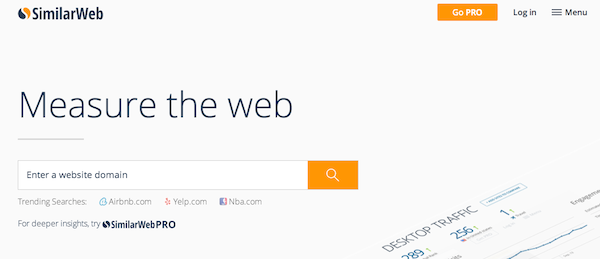
The SimilarWeb Group has raised over $25 million in funding (CrunchBase) to take on its competitor Alexa .
It’s one of the newer marketing research tools in the market and has quickly become my go-to resource for website analysis and competitive research.
SimilarWeb offers a free version and three different paid subscriptions. The free version already offers a lot more data than competitors like Alexa.com.
There are currently three PRO subscriptions which get you access to all features including more detailed reports:
- basic plan ($199 p/m)
- advanced plan ($499 p/m)
- team plan ($999 p/m)
This article is a review of the SimilarWeb PRO advanced plan, its features and some examples of how I use the tool in my everyday work.
Many of the analyses I discuss in this article can be done using the free version as well, however the level of detail of the reports is more limited.
The #1 Online Marketing Challenge
One of the major challenges online is to determine where your marketing efforts generate the best return on investment.
- Search engine advertising?
- Search engine optimisation?
- Social advertising?
- Mobile advertising?
- Native advertising?
- Pay per view advertising?
For every market there are normally several business models. And for each business model there are also different marketing strategies that work.
SimilarWeb is a great tool to analyze different business models and online marketing strategies in the same market in order to find new, profitable traffic sources.
How To Reverse Engineer Online Marketing Strategies
Instead of spending thousands of ad dollar on different marketing strategies, it makes sense to do your research first and then allocate test budgets to specific initiatives.
When I work with clients or on my on projects, I often use SimilarWeb to reverse engineer marketing strategies of specific competitors or even an entire industry.
My research strategy is to go from broad (market research) to narrow (competitor research):
Step 1: Market research
In this step I look at the top websites in a market both in a specific country and worldwide:
- Which websites get the most traffic in a market in the most relevant country?
- Which website get the most traffic in other relevant countries or worldwide?
- How do business models differ among the top websites in a given market?
This step allows me to get to know the top websites in a market both in specific countries and worldwide.
Step 2: Competitor research
Once I have a list of the top websites in a market, I look at each of them in more detail:
- How much traffic are the top competitors getting?
- What are the main traffic sources? (Search, Social, Email, Referral etc.)
- Are they all focussing on the same traffic sources?
- Do the traffic strategies vary across countries?
Let’s look at the different SimilarWeb PRO features which can answer all of these questions.
SimilarWeb PRO: Top Sites Analysis
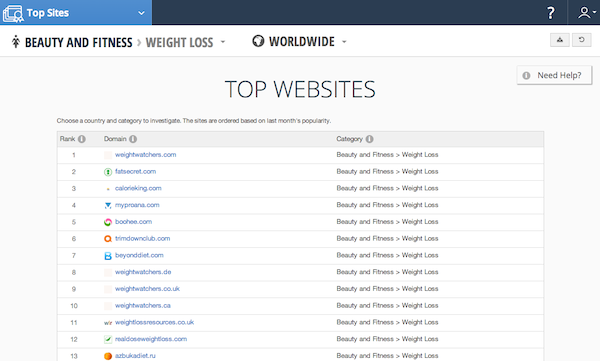
Top weight loss sites worldwide
The feature Top Sites ranks the top 100 websites based on traffic volume by category and country.
It allows you to look at the top 100 websites in a category in specific countries or even worldwide (the free version shows the top 50 websites which is still very helpful).
If your business is based in an English speaking country you could look at the top sites worldwide, in the US and in other English speaking countries like the UK or Australia.
From the overview you can click through to the different websites to get a better understanding of their business model.
A quick look at the top 100 weight loss websites shows that a range of different business models exist:
- Weight loss programs
- Calorie counters
- Body mass index calculators
- Weight loss forums
- Weight loss online magazines
- Diet pill websites
- Food tracking
Your business might only fall into one of these sub-categories.
However, it still makes sense to analyze and understand the business model of other websites and how they are generating their traffic.
A company offering weight loss programs might consider offering a free calorie counter tool on the website to generate more traffic.
Alternatively, the same company could consider contacting the calorie counter websites to sign them up for their affiliate program.
SimilarWeb PRO: Website Analysis
Once you have looked at your market as a whole, you can use the website analysis tool to look at specific sites to understand their business model and how they are generating traffic.
I will continue with the weight loss example to show how valuable this strategy can be.
The following three websites are all selling weight loss programs:
- Weightwatchers.com
- CalorieKing.com
- BeyondDiet.com
Using SimilarWeb’s website analysis tool we can take a look at their traffic sources.
Weightwatchers.com Traffic Sources
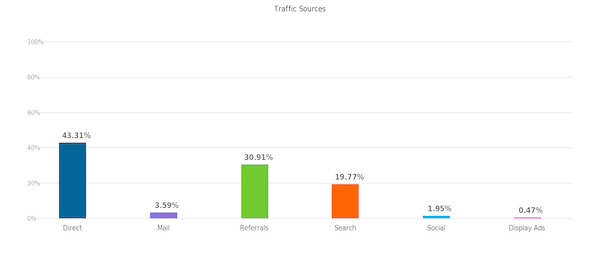
Weightwatchers.com Traffic Sources
43% Direct traffic
More than 40% of the traffic is direct meaning people type the domain in their browser. The is often the case for companies with a strong brand like Weight Watchers.
It is also a result of offline marketing campaigns like TV advertising, radio or direct mail.
31% Referral traffic
Just over 30% of the traffic is coming from referrals meaning other websites linking to WeightWatchers.com.
SimilarWeb PRO also reveals the top 100 referral sites for Weightwatchers.com:
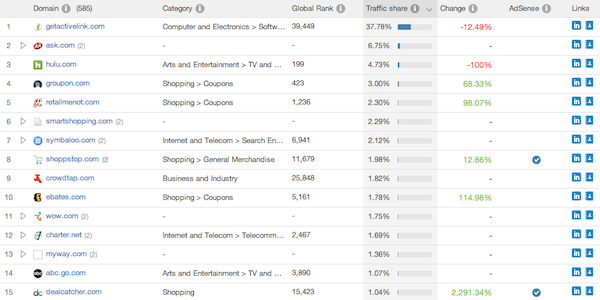
Weightwatchers.com referral traffic
Let’s look at a few of them in more detail:
38% of all referral traffic is derived from getactivelink.com. Upon looking at the website it turns out that Active Link is an activity monitor tool that is part of the Weight Watchers program.
About 7% is coming from Ask.com which is search traffic.
Close to 5% is coming from Hulu.com which is probably advertising traffic.
About 3% of the referral traffic is from Groupon.com, probably a Weight Watchers deal.
20% Search traffic
SimilarWeb PRO shows that 70% of the search traffic is coming from Google, the rest from Bing and other search engines.
89% is organic search traffic and only 11% is paid search traffic.
Most of the search traffic is brand traffic meaning people who are searching for keywords related to weight watchers.
Email, social and display traffic
Only 4% of the traffic is from email marketing, probably from the Weight Watchers newsletter.
Almost no traffic from Facebook or other social platforms. We will see later that one of the other top competitor websites has a much stronger social marketing strategy.
A small percentage of the traffic is generated from display advertising.
CalorieKing.com Traffic Sources
In looking at the traffic sources for CalorieKing.com you’ll notice that the traffic strategy is very different.
Almost 75% of all traffic is generated from search engines.
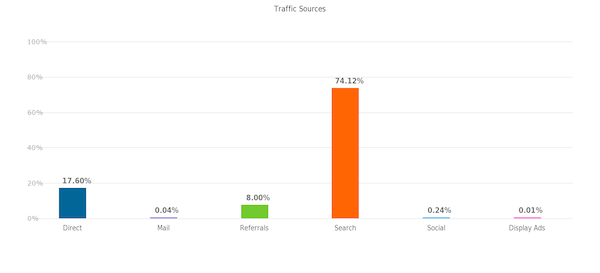
CalorieKing.com Traffic Sources
Let’s take a closer look at the search traffic in SimilarWeb:
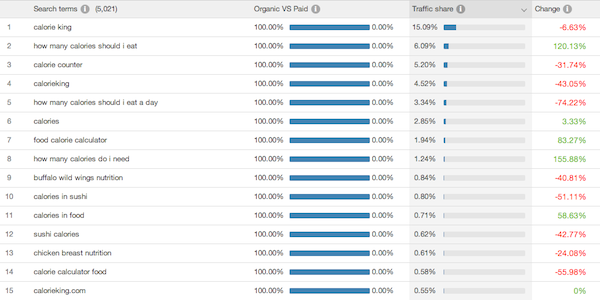
SimilarWeb PRO shows that 100% of the search traffic is organic. 94% of the search traffic is from Google.
The keyword report shows that the entire search strategy is based on free nutrition content.
CalorieKing.com runs a huge content website with calorie and nutritional facts for literally any food you can think of.
Most of the visitors find the site by searching for keywords like “[name of food] calories”, e.g. “sushi calories”.
The traffic strategy mainly relies on just one traffic source: organic search traffic.
Beyonddiet.com Traffic Sources
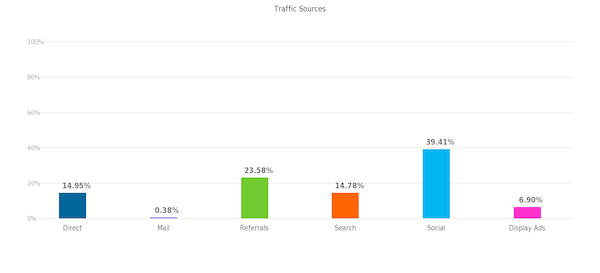
Beyonddiet.com Traffic Sources
Beyonddiet.com again has a very different strategy.
Almost 40% of the Beyonddiet.com traffic is derived from social platforms compared to just 2% for Weightwatchers.com and 0.24% for CalorieKing.com.
The social analysis shows that 98% of the social traffic is comes from Facebook.
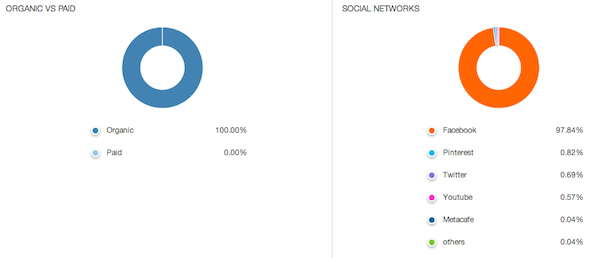
Beyonddiet.com social traffic
It also says that 100% of the Facebook traffic is organic. In looking at the website I found that hard to believe. SimilarWeb might still have issues in terms of detecting organic versus paid Facebook traffic.
As a next step I checked the most popular pages in SimilarWeb PRO and destination URLs where people arrive on the site.
Most of them are tagged using the Google URL builder tool and show “cpc” as medium and Facebook as the source.
This indicates that most of the social traffic is probably from Facebook advertising campaigns and not organic.
If I wanted to investigate this further I would use a Facebook spy tool like SocialAdNinja that I mentioned in my article here.
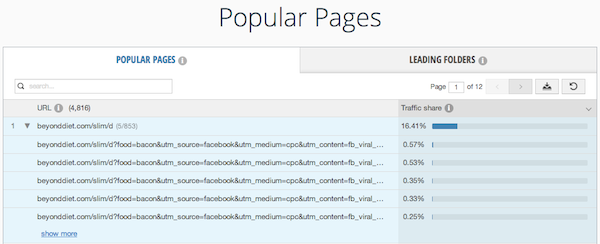
3 High-Traffic Sites with Very Different Marketing Strategies
The purpose of this article was to review SimilarWeb and show how it can be used for competitive research.
In the first step we looked at the top 100 websites in the weight loss category. Using the website analysis tool we then took a closer look at three specific weight loss sites.
Each of these website generates at least a million visitors per month yet they use very different traffic strategies to accomplish this.
Most of the WeightWatchers.com traffic is direct traffic indicating that a lot of offline marketing strategies drive visitors to the website.
CalorieKing.com is focussing on organic search traffic using by providing free calorie and nutrition data on thousands of different foods.
Most of the Beyonddiet.com traffic is generating from Facebook, most likely from Facebook advertising.
Each of these websites focusses on one traffic source. They could all learn from the competitors’ strategies in order to generate more traffic, leads and sales.
This little case study should give you a good idea of the power of competitive research using Similarweb.
But overall I’m a big fan of the tool and will continue to use it for research purposes.
Check out the free version of SimilarWeb here.
You can download the free Chrome extension here.
Check out SimilarWeb PRO here.

No comments yet.